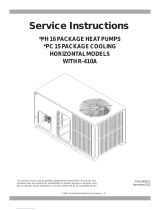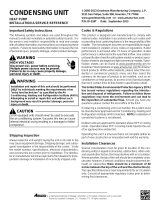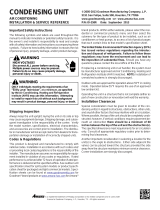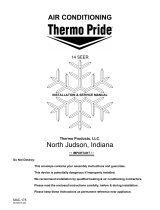
18
SYSTEM OPERATION
Heat Pump Models
Any time the room thermostat is switched to cool, the O
terminal is energized. This energizes the 24 volt coil on the
reversing valve and switches it to the cooling position.
When the contacts of the room thermostat close, this closes
the circuit from R to Y and R to G in the unit.
This energizes the compressor contactor and will energize
the indoor blower following the EBTDR 7 second fan on delay
on models equipped with PSC type blower motors, and in-
stantly on models equipped with EEM blower motors with
the EEM motor.
When the thermostat is satisfied, it opens its contacts break-
ing the low voltage circuit causing the compressor contactor
to open and indoor fan to stop after the EBTDR 65 second
delay on models equipped with PSC type blower motors,
and after the programmed 60 second off delay on models
equipped with EEM blower motors with the EEM motor.
If the room thermostat fan selector switch should be set to
the "on" position then the indoor blower would run continu-
ous rather than cycling with the compressor.
HEATING CYCLE
Cooling Only Units
NOTE: The following only applies if the cooling only unit has
an approved electric heat kit installed for heating. If auxiliary
electric heaters should be used, they may be controlled by
outdoor thermostats (OT18-60A or OT/EHR18-60A).
*PC Models with PSC Type Blower Motors
With the thermostat set to the heat position and a call for
heat, R to W will be energized. This will energize the electric
heat sequencers. When the normally open contacts of the
heat sequencers close, this will energize the electric resis-
tance heat and also the 240 volt coil on the isolation relay in
the control panel. The normally open contacts of the isola-
tion relay will close energizing the indoor blower motor through
the normally closed contacts of the EBTDR.
When the thermostat is satisfied, this breaks the circuit from
R to W. This will turn off the electric heaters, and the indoor
blower after the programmed 60 second off delay on 5 ton
units with the EEM motor.
*PC Models Equipped with EEM Blower Motors
With the thermostat set to the heat position and a call for
heat, R to W will be energized. This will energize the electric
heat sequencers and the EEM
motor. The electric heat will
be energized through the normally open contacts of the elec-
tric heat sequencers. The indoor blower will be energized
through W from the thermostat.
When the thermostat is satisfied, this breaks the circuit from
R to W. This will turn off the electric heaters, and the indoor
blower after the programmed 60 second off delay .
COOLING
The refrigerant used in the system is R-410A. It is a clear,
colorless, non-toxic and non-irritating liquid. R-410A is a 50:50
blend of R-32 and R-125. The boiling point at atmospheric
pressure is -62.9°F.
A few of the important principles that make the refrigeration
cycle possible are: heat always flows from a warmer to a
cooler body. Under lower pressure, a refrigerant will absorb
heat and vaporize at a low temperature. The vapors may be
drawn off and condensed at a higher pressure and tempera-
ture to be used again.
The indoor evaporator coil functions to cool and dehumidify
the air conditioned spaces through the evaporative process
taking place within the coil tubes.
Heat is continually being transferred to the cool fins and tubes
of the indoor evaporator coil by the warm system air. This
warming process causes the refrigerant to boil. The heat re-
moved from the air is carried off by the vapor.
As the vapor passes through the last tubes of the coil, it
becomes superheated. That is, it absorbs more heat than is
necessary to vaporize it. This is assurance that only dry gas
will reach the compressor. Liquid reaching the compressor
can weaken or break compressor valves.
The compressor increases the pressure of the gas, thus add-
ing more heat, and discharges hot, high pressure superheated
gas into the outdoor condenser coil.
In the condenser coil, the hot refrigerant gas, being warmer
than the outdoor air, first loses its superheat by heat trans-
ferred from the gas through the tubes and fins of the coil. The
refrigerant now becomes saturated, part liquid, part vapor and
then continues to give up heat until it condenses to a liquid
alone. Once the vapor is fully liquefied, it continues to give up
heat which subcools the liquid, and it is ready to repeat the
cycle.
COOLING CYCLE
Cooling Only Models
When the contacts of the room thermostat close, making
terminals R to Y and R to G, the low voltage circuit to the
contactor is completed starting the compressor and outdoor
fan motor. This also energizes the indoor blower through the
normally open contacts of the EBTDR on models equipped
with PSC type blower motors, and through the blower relay
on models equipped with EEM blower motors.
When the thermostat is satisfied, breaking the circuit be-
tween R to Y and R to G, the compressor and outdoor fan
motor will stop. The indoor blower will stop after the fan off
delay.
If the room thermostat fan selector switch should be set to
the "on" position then the indoor blower would run continu-
ous rather than cycling with the compressor.
SYSTEM OPERATION *PC/*PH[13-14]**H41*


























